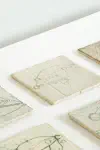
Tablets
Support : Fédération Wallonie-Bruxelles
Thanks to : Frizbee ceramics
Photo credits : Dana Savic, Guillaume Slizewicz
An exploration of the relationship between clay and information through proto-writing, scientific diagrams, and menhirs.
In the context of MODERN CRAFT #2 — The Power of Ceramics at MAD Brussels I had the chance to exhibit the first part of my project tablets, inspired on the relationship between clay and information through proto-writing, neural representation, scientific diagrams, and menhir statue from the south of france.
Pottery is one of the most ancestral technologies humans have, but beyond being used for cooking, drinking and eating, clay has also been used as a way to communicate. Due to its longevity, Clay is also how we have access to former people’s visual repertoire, graphic representations, accounting methods and alphabet.The tiles I present are made using a needle, a diagram-generation algorithm and a robotic arm. The old ritual of writing on clay is carried out by semi-autonomous technologies to produce new artefacts.
The project is the culmination of a creative process inspired by archaeological, scientific, and computer-related elements.
The starting point of this project was my discovery of the menhirs in the southern region of France, which showed how simple forms could evoke human faces and people through their simplicity and brutality. This discovery led me to delve deeper into proto-writing and its appearance at different times in different parts of the world. Jihau in China, Dispilio in Greece, Vinča in Serbia, Cascajal in South America, Kisch in Mesopotamia… Through these signs, we can understand part of the culture of these peoples but also find common ground, a shared vision of the representation of the world. Most of these proto-writings have come down to us through ceramics, which withstands time and gives us a window through the ages.
In parallel with this research on proto-writing, I became interested in how scientists have tried to represent the complexity of human thought. From linguistics with Hofstadter’s concept maps, to the materialization of neuronal mechanisms in the last 50 years, we see the richness of these forms and diagrams, which have their own beauty beyond their informative or explanatory aspect.
Today, computer researchers widely use these diagrams when they explain how algorithms work, particularly by using the graphviz library (a program), which allows them to be generated from straightforward instructions. Having already used this algorithm to explain mechanisms or to clarify certain relationships, I decided to use it for purely aesthetic purposes. This program has the advantage of automatically placing the different elements on a 2-dimensional plane, starting from a set of instructions that can be given to it. To focus on this visual aspect, I used it by removing all data and information, keeping only the signs, circles, arrows, and lines. To do this, I created an algorithm randomly generating instructions that Graphviz interprets and transforms into a diagram.
I then used an articulated arm to draw on freshly cut clay tiles. The result is first fired at 960 degrees, allowing me to apply a juice of copper, iron, cobalt, or manganese, filling the cavities the needle creates. The result shows lines ranging from green to black.
The project tablets was supported by the Fédération Wallonie Bruxelles.
